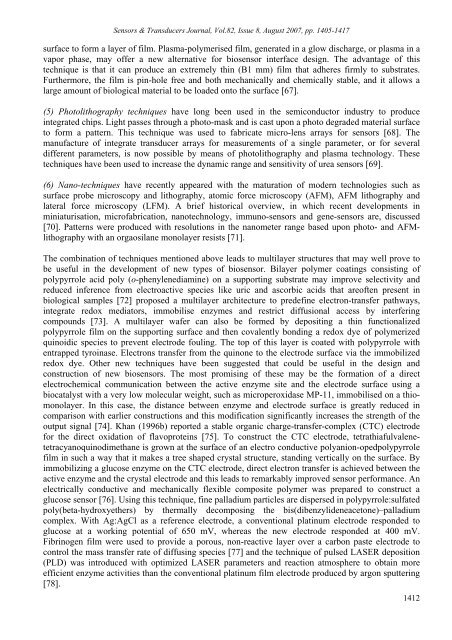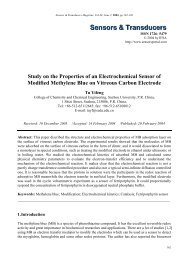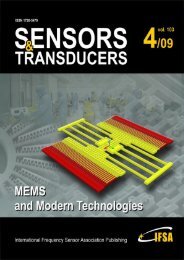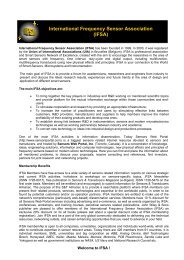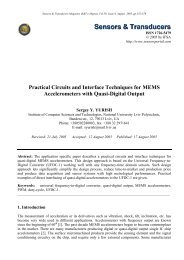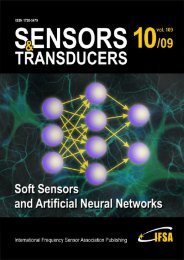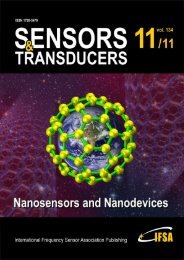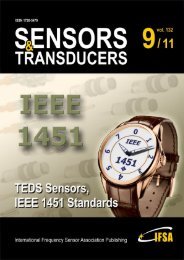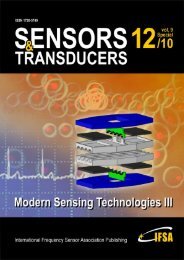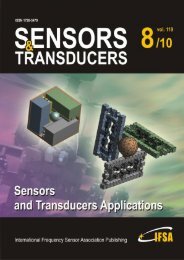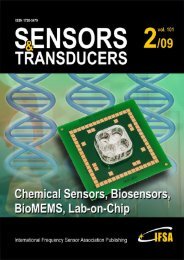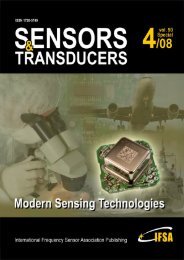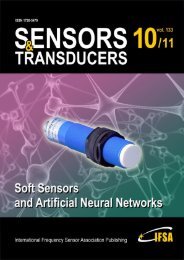Bio-Techniques in Electrochemical Transducers: an Overview
Bio-Techniques in Electrochemical Transducers: an Overview
Bio-Techniques in Electrochemical Transducers: an Overview
Create successful ePaper yourself
Turn your PDF publications into a flip-book with our unique Google optimized e-Paper software.
Sensors & <strong>Tr<strong>an</strong>sducers</strong> Journal, Vol.82, Issue 8, August 2007, pp. 1405-1417<br />
surface to form a layer of film. Plasma-polymerised film, generated <strong>in</strong> a glow discharge, or plasma <strong>in</strong> a<br />
vapor phase, may offer a new alternative for biosensor <strong>in</strong>terface design. The adv<strong>an</strong>tage of this<br />
technique is that it c<strong>an</strong> produce <strong>an</strong> extremely th<strong>in</strong> (B1 mm) film that adheres firmly to substrates.<br />
Furthermore, the film is p<strong>in</strong>-hole free <strong>an</strong>d both mech<strong>an</strong>ically <strong>an</strong>d chemically stable, <strong>an</strong>d it allows a<br />
large amount of biological material to be loaded onto the surface [67].<br />
(5) Photolithography techniques have long been used <strong>in</strong> the semiconductor <strong>in</strong>dustry to produce<br />
<strong>in</strong>tegrated chips. Light passes through a photo-mask <strong>an</strong>d is cast upon a photo degraded material surface<br />
to form a pattern. This technique was used to fabricate micro-lens arrays for sensors [68]. The<br />
m<strong>an</strong>ufacture of <strong>in</strong>tegrate tr<strong>an</strong>sducer arrays for measurements of a s<strong>in</strong>gle parameter, or for several<br />
different parameters, is now possible by me<strong>an</strong>s of photolithography <strong>an</strong>d plasma technology. These<br />
techniques have been used to <strong>in</strong>crease the dynamic r<strong>an</strong>ge <strong>an</strong>d sensitivity of urea sensors [69].<br />
(6) N<strong>an</strong>o-techniques have recently appeared with the maturation of modern technologies such as<br />
surface probe microscopy <strong>an</strong>d lithography, atomic force microscopy (AFM), AFM lithography <strong>an</strong>d<br />
lateral force microscopy (LFM). A brief historical overview, <strong>in</strong> which recent developments <strong>in</strong><br />
m<strong>in</strong>iaturisation, microfabrication, n<strong>an</strong>otechnology, immuno-sensors <strong>an</strong>d gene-sensors are, discussed<br />
[70]. Patterns were produced with resolutions <strong>in</strong> the n<strong>an</strong>ometer r<strong>an</strong>ge based upon photo- <strong>an</strong>d AFM-<br />
lithography with <strong>an</strong> orgaosil<strong>an</strong>e monolayer resists [71].<br />
The comb<strong>in</strong>ation of techniques mentioned above leads to multilayer structures that may well prove to<br />
be useful <strong>in</strong> the development of new types of biosensor. Bilayer polymer coat<strong>in</strong>gs consist<strong>in</strong>g of<br />
polypyrrole acid poly (o-phenylenediam<strong>in</strong>e) on a support<strong>in</strong>g substrate may improve selectivity <strong>an</strong>d<br />
reduced <strong>in</strong>ference from electroactive species like uric <strong>an</strong>d ascorbic acids that areoften present <strong>in</strong><br />
biological samples [72] proposed a multilayer architecture to predef<strong>in</strong>e electron-tr<strong>an</strong>sfer pathways,<br />
<strong>in</strong>tegrate redox mediators, immobilise enzymes <strong>an</strong>d restrict diffusional access by <strong>in</strong>terfer<strong>in</strong>g<br />
compounds [73]. A multilayer wafer c<strong>an</strong> also be formed by deposit<strong>in</strong>g a th<strong>in</strong> functionalized<br />
polypyrrole film on the support<strong>in</strong>g surface <strong>an</strong>d then covalently bond<strong>in</strong>g a redox dye of polymerized<br />
qu<strong>in</strong>oidic species to prevent electrode foul<strong>in</strong>g. The top of this layer is coated with polypyrrole with<br />
entrapped tyro<strong>in</strong>ase. Electrons tr<strong>an</strong>sfer from the qu<strong>in</strong>one to the electrode surface via the immobilized<br />
redox dye. Other new techniques have been suggested that could be useful <strong>in</strong> the design <strong>an</strong>d<br />
construction of new biosensors. The most promis<strong>in</strong>g of these may be the formation of a direct<br />
electrochemical communication between the active enzyme site <strong>an</strong>d the electrode surface us<strong>in</strong>g a<br />
biocatalyst with a very low molecular weight, such as microperoxidase MP-11, immobilised on a thiomonolayer.<br />
In this case, the dist<strong>an</strong>ce between enzyme <strong>an</strong>d electrode surface is greatly reduced <strong>in</strong><br />
comparison with earlier constructions <strong>an</strong>d this modification signific<strong>an</strong>tly <strong>in</strong>creases the strength of the<br />
output signal [74]. Kh<strong>an</strong> (1996b) reported a stable org<strong>an</strong>ic charge-tr<strong>an</strong>sfer-complex (CTC) electrode<br />
for the direct oxidation of flavoprote<strong>in</strong>s [75]. To construct the CTC electrode, tetrathiafulvalenetetracy<strong>an</strong>oqu<strong>in</strong>odimeth<strong>an</strong>e<br />
is grown at the surface of <strong>an</strong> electro conductive poly<strong>an</strong>ion-opedpolypyrrole<br />
film <strong>in</strong> such a way that it makes a tree shaped crystal structure, st<strong>an</strong>d<strong>in</strong>g vertically on the surface. By<br />
immobiliz<strong>in</strong>g a glucose enzyme on the CTC electrode, direct electron tr<strong>an</strong>sfer is achieved between the<br />
active enzyme <strong>an</strong>d the crystal electrode <strong>an</strong>d this leads to remarkably improved sensor perform<strong>an</strong>ce. An<br />
electrically conductive <strong>an</strong>d mech<strong>an</strong>ically flexible composite polymer was prepared to construct a<br />
glucose sensor [76]. Us<strong>in</strong>g this technique, f<strong>in</strong>e palladium particles are dispersed <strong>in</strong> polypyrrole:sulfated<br />
poly(beta-hydroxyethers) by thermally decompos<strong>in</strong>g the bis(dibenzylideneacetone)–palladium<br />
complex. With Ag:AgCl as a reference electrode, a conventional plat<strong>in</strong>um electrode responded to<br />
glucose at a work<strong>in</strong>g potential of 650 mV, whereas the new electrode responded at 400 mV.<br />
Fibr<strong>in</strong>ogen film were used to provide a porous, non-reactive layer over a carbon paste electrode to<br />
control the mass tr<strong>an</strong>sfer rate of diffus<strong>in</strong>g species [77] <strong>an</strong>d the technique of pulsed LASER deposition<br />
(PLD) was <strong>in</strong>troduced with optimized LASER parameters <strong>an</strong>d reaction atmosphere to obta<strong>in</strong> more<br />
efficient enzyme activities th<strong>an</strong> the conventional plat<strong>in</strong>um film electrode produced by argon sputter<strong>in</strong>g<br />
[78].<br />
1412


